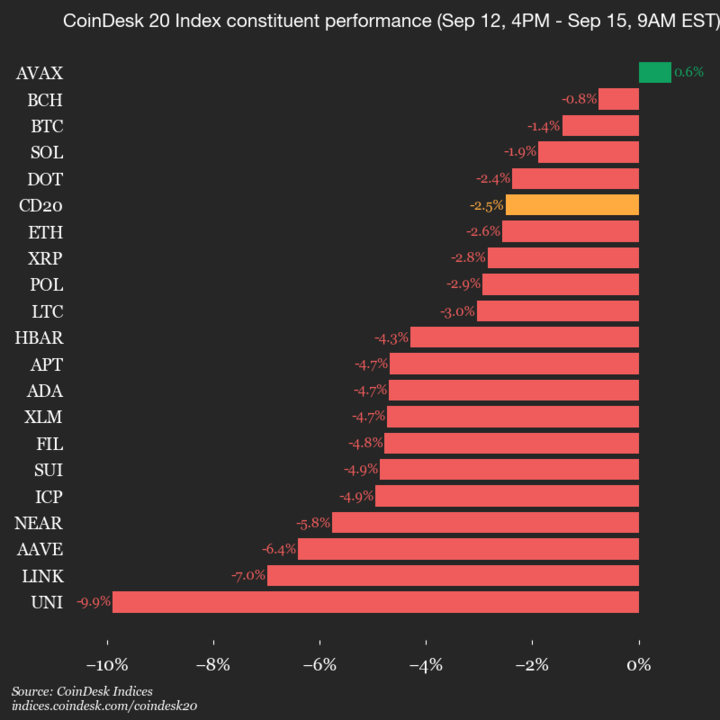Uncategorized
Coinbase Q4 Earnings Expected to Show Best Volume Since 2021

The fourth quarter was a good one for crypto and Wall Street analysts expect leading U.S. exchange Coinbase (COIN) to have posted a big jump in earnings from the prior three months.
Revenue for the fourth quarter is expected to have been $1.8 billion, according to FactSet, up from $1.26 billion in the third quarter. Earnings-per-share are estimated to have risen to $1.99 from $0.41.
Maybe more importantly, thanks to the major rally across crypto following Donald Trump’s presidential election victory, analysts expect exchange volume to have risen to $195.9 billion in the year’s final three months from $185.3 billion in the third quarter. That $195.9 billion figure would be the strongest quarterly result since the fourth quarter of 2021.
“We maintain our bullish thesis on COIN, seeing the company well positioned to benefit as crypto begins a potential transition into a new era,” analysts at Citi bank wrote in a note.
The bank has a buy rating on the stock and this week increased its price target to $350 from $275. Shares on Tuesday are trading at $270, ahead nearly 90% from the year-ago level. The Citi team, however, does expect Coinbase to report fourth quarter revenue of $1.7 billion, missing the $1.8 billion consensus estimate.
The November election was a “monumental catalyst for the crypto ecosystem,» wrote JPMorgan’s Ken Worthington, who nevertheless remains neutral on the shares. He sees fourth quarter revenue at $1.77 billion, also a miss from the $1.8 billion estimate.
Outlook on 2025
While the final months of 2024 had many catalysts for crypto and thus Coinbase, 2025 is hard to predict as policy changes typically take some time to go into effect, say some Wall Street analysts.
“For [2025], we assume static crypto prices and factor more normalized volumes resulting in 6% YoY transaction revenue growth vs. consensus of 3% growth,” Citi said.
“Not unlike in the past, we expect the stock to remain as a ‘risk-on’ play throughout 2025 and will likely remain volatile around macro developments and swings in market sentiment,» Citi continued. «That being said, we expect the next 1-2 years to be highly formative for Coinbase’s business model/competitive strategy, as well as for the greater digital asset space.”
One of Coinbase’s main priorities over the past year has been to diversify its revenue stream, 50% of which still comes from trading fees. Retail traders, which pay the highest trading fee, still have not returned to the same levels seen in 2021, according to research firm Kaiko. The share of volume coming from that clientele shrank to just 18%, down from 40% in 2021, which continues to weigh on transaction revenue, Kaiko said.
According to Citi, Coinbase could solve this issue in 2025 by leaning further into the tokenization of assets, embedded smart contract applications and Web3, the potential efficiencies in cross-border and remittance, as well as using the blockchain as an AI governance tool, among others.
“In our view, the next evolution for Coinbase’s growth trajectory will rely on utility… an area with many proofs-of-concepts, but perhaps waiting to be unlocked with clearer rules,” the bank’s analysts wrote.
Uncategorized
CoinDesk 20 Performance Update: Index Drops 2.5% as Nearly All Constituents Decline

CoinDesk Indices presents its daily market update, highlighting the performance of leaders and laggards in the CoinDesk 20 Index.
The CoinDesk 20 is currently trading at 4248.74, down 2.5% (-109.09) since 4 p.m. ET on Monday.
One of 20 assets is trading higher.

Leaders: AVAX (+0.6%) and BCH (-0.8%).
Laggards: UNI (-9.9%) and LINK (-7.0%).
The CoinDesk 20 is a broad-based index traded on multiple platforms in several regions globally.
Uncategorized
Pantera-Backed Solana Treasury Firm Helius Raises $500M, Stock Soars Over 200%

Helius Medical Technologies (HSDT) announced on Monday it’s raising more than $500 million in a private financing round to create a Solana-focused treasury company.
The vehicle will hold SOL, the native token of the Solana blockchain, as its reserve asset and aims to expand to more than $1.25 billion via stock warrants tied to the deal, the press release said.
The financing was led by Pantera Capital and Summer Capital, with participation from investors including Animoca Brands, FalconX and HashKey Capital.
Shares of the firm rallied over 200% above $24 in pre-market trading following the announcement. Solana was down 4% over the past 24 hours.
The firm is joining the latest wave of new digital asset treasuries, or DATs, with public companies pivoting to raise funds and buy cryptocurrencies like bitcoin (BTC), ether (ETH) or SOL.
Helius is set to rival with the recently launched Forward Industries (FORD) with a $1.65 billion war chest backed by Galaxy Digital and others. That firm confirmed on Monday that has already purchased 6.8 million tokens for roughly $1.58 billion last week.
Helius’ plan is to use Solana’s yield-bearing design to generate income on the holdings, earning staking rewards of around 7% as well as deploying tokens in decentralized finance (DeFi) and lending opportunities. Incoming executive chairman Joseph Chee, founder of Summer Capital and a former UBS banker, will lead the firm’s digital asset strategy alongside Pantera’s Cosmo Jiang and Dan Morehead.
«As a pioneer in the digital asset treasury space, having participated in the formation of the strategy at Twenty One Capital (CEP) with Tether, Softbank and Cantor, Bitmine (BMNR) with Tom Lee and Mozayyx as well as EightCo (OCTO) with Dan Ives and Sam Altman, we have built the expertise to set up the pre-eminent Solana treasury vehicle,» Cosmo Jiang, general partner at Pantera Capital, said in a statement.
«There is a real opportunity to drive the flywheel of creating shareholder value that Michael Saylor has pioneered with Strategy by accelerating Solana adoption,» he added.
Read more: Solana Surges as Galaxy Scoops Up Over $700M Tokens From Exchanges
Uncategorized
American Express Introduces Blockchain-Based ‘Travel Stamps’

American Express has introduced Ethereum-based ‘travel stamps’ to create a commemorative record of travel experiences, as part of the firm’s revamped travel app.
The travel experience tokens, which are technically NFTs (ERC 721 tokens), are minted and stored on Coinbase’s Base network, said Colin Marlowe , VP, Emerging Partnerships at Amex Digital Labs.
The travel stamps, which can be collected anytime a traveler uses their card, are not tradable NTF tokens, Marlowe explained, and neither do they function like blockchain-based loyalty points – at least for the time being.
“It’s a valueless ERC-721, so technically an NFT, but we just didn’t brand it as such. We wanted to speak to it in a way that was natural for the travel experience itself, and so we talk about these things as stamps, and they’re represented as tokens,” Marlowe said in an interview.
“As an identifier and representation of history the stamps could create interesting partnership angles over time. We weren’t trying to sell these or sort of generate any like short term revenue. The angle is to make a travel experience with Amex feel really rich, really different, and kind of set it apart,” he said.
The Amex travel app also includes a range of tools for travels and Centurion Lounge upgrades, the company said.
-

 Business11 месяцев ago
Business11 месяцев ago3 Ways to make your business presentation more relatable
-

 Fashion11 месяцев ago
Fashion11 месяцев agoAccording to Dior Couture, this taboo fashion accessory is back
-

 Entertainment11 месяцев ago
Entertainment11 месяцев ago10 Artists who retired from music and made a comeback
-

 Entertainment11 месяцев ago
Entertainment11 месяцев ago\’Better Call Saul\’ has been renewed for a fourth season
-

 Entertainment11 месяцев ago
Entertainment11 месяцев agoNew Season 8 Walking Dead trailer flashes forward in time
-

 Business11 месяцев ago
Business11 месяцев ago15 Habits that could be hurting your business relationships
-

 Entertainment11 месяцев ago
Entertainment11 месяцев agoMeet Superman\’s grandfather in new trailer for Krypton
-

 Entertainment11 месяцев ago
Entertainment11 месяцев agoDisney\’s live-action Aladdin finally finds its stars





